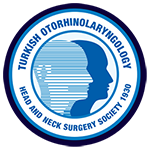ABSTRACT
Objective:
Many studies enquiring the etiology of chronic sinusitis and nasal polyposis are being carried out. In recent years the following hypothesis is being discussed. In our study, we searched for the susceptibility of chronic rhinosinusitis and nasal polyposis patients against fungal allergens, which in turn could end up with allergic reactions in the sinonasal mucosa.
Methods:
In this study, 67 patients (50 males and 17 females) who have applied to the Department of Otorhinolaryngology Head and Neck Surgery of the PTT Training and Research Hospital, being diagnosed with chronic rhinosinusitis and nasal polyposis were investigated. In this study the eosinophil counts and total IgE levels of the patients were determined; also skin tests to determine the sensitivity against fungal allergens were also carried out. The specimens taken from the patients during the operation were investigated for the presence of fungi in microbiology laboratories.
Results:
As a result of the histopathological examinations, allergic mucin was detected in 70%, allergic polyposis in 62% and fungus elements in 10% of the 67 patients. By showing the presence of fungus in the sinonasal mucosa in %20 of the immunological, histopathological and cultural tests results, the diagnosis of allergic fungal sinusitis was proved.
Conclusion:
The role of the allergic reactions developing against fungi, in the etiology of chronical rhinosinusitis and nasal polyposis are still under discussion. In our study, we detected allergic reactions that developed against fungal cells to be responsible for chronic rhinosinusitis and nasal polyposis in 20% of our patients.
ÖZET
Amaç:
Kronik rinosinüzit ve nazal polipozis etyolojisi son yıllarda ri-nolojide en çok tartışılan konuların başında gelmektedir. Bu amaçla planlanan çalışmada kronik rinosinüzit ve nazal polipozis etyolojisin-de sinonazal mukozada mantarlara karşı oluşan alerjik reaksiyonların rolü araştırılmıştır.
Yöntem:
PTT Eğitim ve Araştırma Hastanesi KBB Kliniği'ne başvuran kronik rinosinüzit ve nazal polipozis tanısı konulup, operasyon kararı alınan, 50'si erkek, 17'si kadın, toplam 67 hasta çalışmanın kapsamını oluşturmaktadır. Çalışmada hastaların eozinofil değerleri ve total IgE seviyeleri araştırılarak, mantar alerjenlerine karşı duyarlılıklarının tespiti için deri testleri yapıldı. Ayrıca operasyon sırasında elde edilen materyaller patoloji ve mikrobiyoloji laboratuarlarına gönderilerek mantar varlığına bakıldı.
Bulgular:
Histopatolojik incelemelerde 67 hastanın %70'inde alerjik müsin, %62'sinde alerjik polip ve %10'unda mantar elemanları tespit edildi. Hastaların kültür, histopatoloji ve immünoloji testlerinin sonucunda %20'sinde sinonazal mukozada mantar varlığı gösterilerek, mantarlara karşı oluşan alerjik reaksiyon kanıtlandı.
Sonuç:
Kronik rinosinüzit ve nazal polipozis oluşumunda mantarlara karşı oluşan alerjik reaksiyonun ne oranda sorumlu olduğu hala tartışılmaktadır. Çalışmamızda hastaların %20'sinde mantar hücrelerine karşı alerjik reaksiyon olduğu görüldü. Mantar hücrelerinin tespitine yönelik tanı yöntemlerinin geliştirilmesi ile bu oranın daha da artabileceğini düşünüyoruz.



